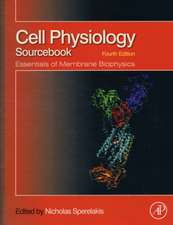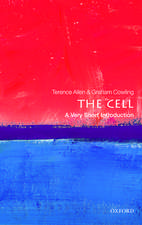Recombination and Meiosis: Crossing-Over and Disjunction: Genome Dynamics and Stability, cartea 2
Editat de Richard Egel, Dirk-Henner Lankenauen Limba Engleză Hardback – 7 dec 2007
| Toate formatele și edițiile | Preț | Express |
|---|---|---|
| Paperback (2) | 1222.31 lei 6-8 săpt. | |
| Springer Berlin, Heidelberg – 25 noi 2010 | 1222.31 lei 6-8 săpt. | |
| Springer Berlin, Heidelberg – 25 noi 2010 | 1547.50 lei 39-44 zile | |
| Hardback (2) | 1231.47 lei 6-8 săpt. | |
| Springer Berlin, Heidelberg – 18 aug 2008 | 1231.47 lei 6-8 săpt. | |
| Springer Berlin, Heidelberg – 7 dec 2007 | 1826.07 lei 6-8 săpt. |
Preț: 1826.07 lei
Preț vechi: 2226.90 lei
-18% Nou
Puncte Express: 2739
Preț estimativ în valută:
349.42€ • 364.11$ • 289.32£
349.42€ • 364.11$ • 289.32£
Carte tipărită la comandă
Livrare economică 03-17 aprilie
Preluare comenzi: 021 569.72.76
Specificații
ISBN-13: 9783540753711
ISBN-10: 3540753710
Pagini: 380
Ilustrații: XV, 365 p.
Dimensiuni: 155 x 235 x 24 mm
Greutate: 0.71 kg
Ediția:2008
Editura: Springer Berlin, Heidelberg
Colecția Springer
Seria Genome Dynamics and Stability
Locul publicării:Berlin, Heidelberg, Germany
ISBN-10: 3540753710
Pagini: 380
Ilustrații: XV, 365 p.
Dimensiuni: 155 x 235 x 24 mm
Greutate: 0.71 kg
Ediția:2008
Editura: Springer Berlin, Heidelberg
Colecția Springer
Seria Genome Dynamics and Stability
Locul publicării:Berlin, Heidelberg, Germany
Public țintă
ResearchCuprins
Meiotic Crossing-Over and Disjunction: Overt and Hidden Layers of Description and Control.- Chromatid Cores in Meiotic Chromosome Structure and Segregation.- Sister Chromatid Cohesion and Centromere Organization in Meiosis.- Spo11 and the Formation of DNA Double-Strand Breaks in Meiosis.- Synapsis, Double-Strand Breaks, and Domains of Crossover Control in Drosophila Females.- Synaptic and Recombination Nodules in Mammals: Structural Continuity with Shifting Protein Composition.- Human Recombination Hotspots: Before and After the HapMap Project.- Meiotic Nondisjunction—The Major Cause of Trisomy 21.- Meiosis in Arabidopis thaliana: Recombination, Chromosome Organization and Meiotic Progression.- Modified Cell Cycle Regulation in Meiosis.
Textul de pe ultima copertă
Once per life cycle, mitotic nuclear divisions are replaced by meiosis I and II – reducing chromosome number from the diploid level to a haploid genome, reshuffling the homologous chromosomes by their centromeres, and recombining chromosome arms by crossing-over. In animals, including humans, all this happens during the germ cell formation of eggs and sperm. Due to the reign of meiosis, no child is a true genetic copy of either parent. Central to mainstream meiosis, the mechanisms of reciprocal exchange at crossover/chiasma sites stand out as a controlled program of biologically significant molecular changes. To initiate the meiotic exchange of DNA, surgical cuts are made as a form of calculated damage that is subsequently repaired by homologous recombination. These key events are accompanied by ancillary provisions at the level of chromosome core organization, sister chromatid cohesion, and differential centromere connectivity. Great progress has been made in recent years to further our understanding of these mechanisms. Questions still open primarily concern the placement of and mutual coordination between neighboring crossover events. The current book addresses these processes and mechanisms in multicellular eukaryotes, such as Drosophila, Arabidopsis, mice and humans. The pioneering model systems of yeasts, as well as evolutionary aspects, will be addressed in a forthcoming volume.
Caracteristici
First book to give a detailed insight in the processes and mechanisms taking place in the cell during meiosis and recombination Written by high-impact authors from the field











